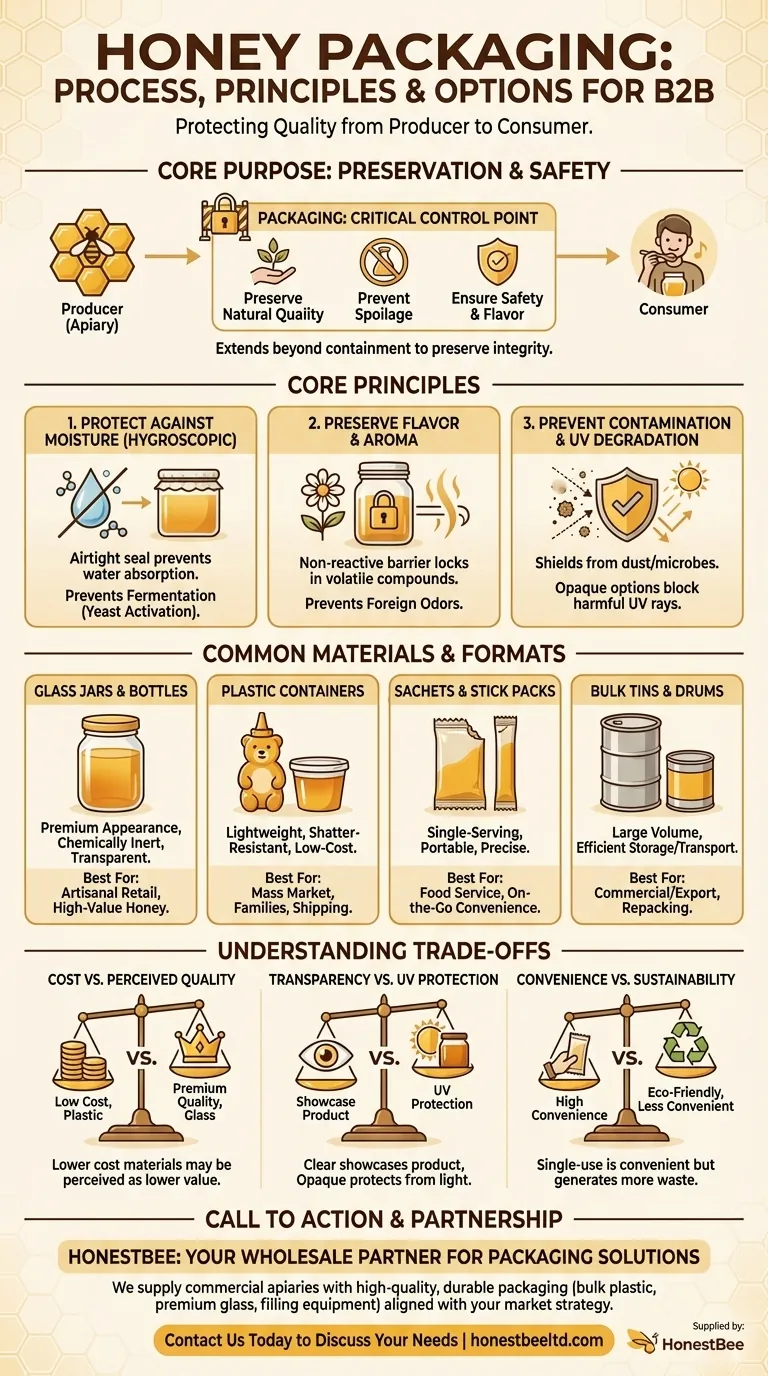At its core, honey packaging is the process of filling and sealing honey into a variety of containers using manual or automated machinery. The most common materials are glass jars, food-grade plastic bottles, and single-serving sachets, chosen based on the target market and the need to protect the honey's quality from extraction to consumption.
The central purpose of honey packaging extends far beyond simple containment. It is a critical control point for preserving the honey's natural quality, preventing spoilage from moisture and light, and ensuring its safety and flavor remain intact from the producer to the consumer.

The Core Principles of Honey Packaging
Effective packaging is a necessity for maintaining the integrity of honey. The choice of container and sealing method is dictated by a few fundamental scientific and marketing principles.
Protecting Against Moisture and Fermentation
Honey is hygroscopic, meaning it naturally absorbs moisture from the surrounding air.
If a container is not perfectly airtight, the honey will draw in water. This increases its water content, creating an environment where dormant yeasts can activate and begin to ferment the honey, spoiling its flavor and quality.
Preserving Natural Flavor and Aroma
A secure, non-reactive container acts as a barrier, locking in the volatile aromatic compounds that give different honey varietals their unique flavors and scents.
Improper packaging can allow these delicate notes to escape or can introduce foreign odors, permanently altering the product's profile.
Preventing Contamination and Degradation
Packaging shields the honey from environmental contaminants like dust and microbes.
It also protects against UV degradation from sunlight, which can darken the honey and diminish its natural enzymes and beneficial properties. Storing honey in a dark place or using opaque containers mitigates this risk.
Common Packaging Materials and Formats
The container a producer chooses directly impacts cost, market appeal, and product protection.
Glass Jars and Bottles
Glass is a traditional and popular choice, favored for its premium appearance and the fact that it is chemically inert, meaning it won't react with the honey.
Its transparency allows consumers to see the product's color and clarity, which is a major purchasing factor.
Food-Grade Plastic Containers
Plastic bottles, tubs, and "bear" shaped containers are valued for being lightweight, shatter-resistant, and low-cost.
These qualities make them highly practical for shipping and for households with children. It is critical that only food-grade plastic is used.
Sachets and Stick Packs
These single-serving pouches are created by specialized machines that form, fill, and seal honey into small, convenient packets.
They are ideal for the food service industry (restaurants, hotels) and for consumers seeking on-the-go portability.
Bulk Tins and Drums
For commercial or export purposes, honey is often packaged in large, food-grade metal tins or drums. This is an efficient method for storing and transporting large quantities before it is later repacked into smaller retail containers.
Understanding the Trade-offs
Choosing a packaging format involves balancing competing priorities. There is no single "best" option, only the best option for a specific goal.
Cost vs. Perceived Quality
Glass is heavier and more expensive to source and ship, but it conveys a high-end, premium quality. Plastic is significantly cheaper and more durable, but can sometimes be perceived as a lower-value option.
Transparency vs. UV Protection
While clear glass and plastic are excellent for showcasing the honey, they offer minimal protection from sunlight. Opaque or amber-colored glass provides superior UV protection but hides the product from view, representing a direct trade-off between marketing and preservation.
Convenience vs. Sustainability
Single-use sachets offer unmatched convenience but generate more packaging waste. Consumers are increasingly demanding recyclable or biodegradable options, pushing producers to balance the demand for convenience with environmental responsibility.
Making the Right Choice for Your Goal
Your packaging strategy should be a deliberate decision based on your product, brand, and target customer.
- If your primary focus is premium quality and artisanal appeal: Glass jars are the industry standard for showcasing high-value honey and ensuring purity.
- If your primary focus is cost-efficiency and distribution: Food-grade plastic containers offer the best balance of durability, low weight, and affordability.
- If your primary focus is food service or on-the-go convenience: Sachets and stick packs provide precise, portable single servings.
Ultimately, the right packaging protects the integrity of the honey while perfectly aligning with your market strategy.
Summary Table:
| Packaging Material | Key Features | Best For |
|---|---|---|
| Glass Jars | Premium look, inert, transparent | Artisanal/retail honey |
| Plastic Containers | Lightweight, shatter-resistant, cost-effective | Mass market, families |
| Sachets/Stick Packs | Single-serving, portable | Food service, on-the-go |
| Bulk Tins/Drums | Large volume, efficient storage | Commercial/export use |
Optimize your honey packaging with the right supplies. As HONESTBEE, we supply commercial apiaries and beekeeping equipment distributors with high-quality, durable packaging solutions and filling equipment. Whether you need cost-effective plastic containers for bulk distribution or premium glass jars for artisanal branding, we provide wholesale-focused options to protect your honey's quality and align with your market strategy. Contact us today to discuss your packaging needs and enhance your product's appeal and shelf life!
Visual Guide

Related Products
- Hexagonal Glass Honey Jars with Metal Lug Caps Elegant Versatile Packaging
- Classic Drum Shaped Glass Honey Jar with Airtight Lid
- Classic Honey Bear Jars with Flip Top Dispensing Cap for Liquid Sweeteners
- Inverted Squeezable Honey Jar with No Drip Flip Top Cap for Easy Pouring
- Pneumatic Double Nozzle Honey Filling Bottling Packaging Machine
People Also Ask
- What is the term for honey can absorb moisture from the air? Understanding Hygroscopy
- What are the common types of honey packaging? A Guide to Glass, Plastic, Pouches & Tins
- What is the best way to jar honey? Preserve Quality with the Right Container
- What makes raw honey more aesthetically appealing than processed honey? Discover the Beauty of Authenticity
- What are the advantages of using glass jars for honey packaging? Preserve Purity & Elevate Your Brand



















